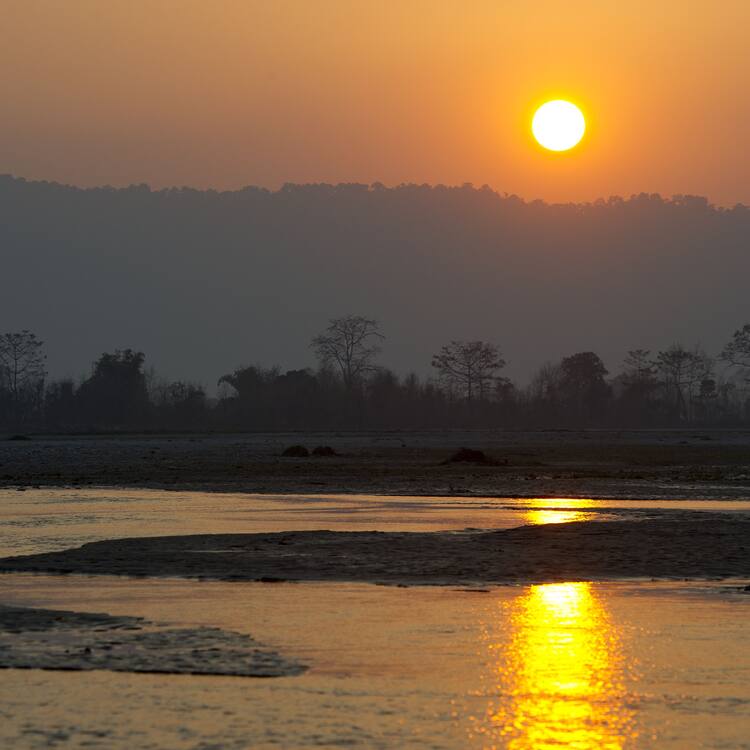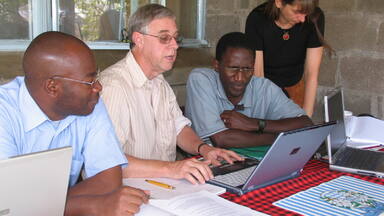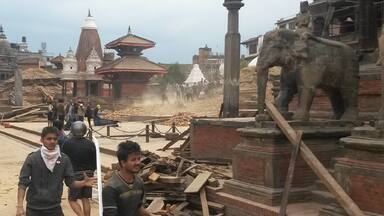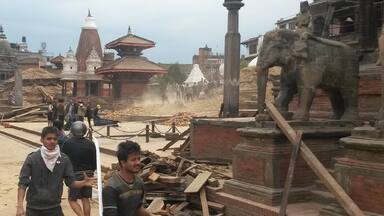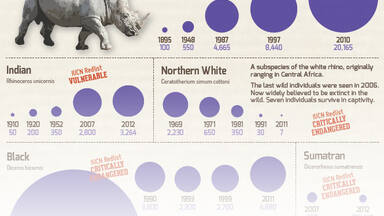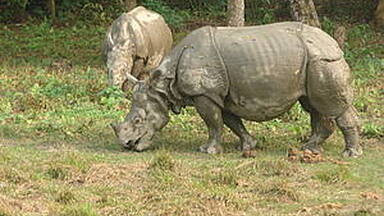Chitwan National Park
Chitwan National Park
At the foot of the Himalayas, Chitwan is one of the few remaining undisturbed vestiges of the 'Terai' region, which formerly extended over the foothills of India and Nepal. It has a particularly rich flora and fauna. One of the last populations of single-horned Asiatic rhinoceros lives in the park, which is also one of the last refuges of the Bengal tiger.
Description is available under license CC-BY-SA IGO 3.0
Parc national de Chitwan
Au pied de l'Himalaya, Chitwan est l'un des rares vestiges non perturbés de la région du « Terai » qui s'étendait sur les piémonts de l'Inde et du Népal. La flore et la faune y sont très denses. Il abrite une des dernières populations de rhinocéros asiatique à une corne et constitue également l'un des derniers refuges du tigre du Bengale.
Description is available under license CC-BY-SA IGO 3.0
منتزه جتوان الملكي الوطني
تُعتبر محمية جتوان التي تقع في أسفل جبال الهملايا، من الآثار النادرة التي لم يتمّ تخريبها في منطقة تيراي التي تمتد على السهول الواقعة في سفوح جبال الهند والنيبال. كما ان تشكيلة النباتات ومجموعة الحيوانات المتواجدة فيها كثيفة وغنية. اذ تأوي إحدى آخر مجموعات وحيد القرن الآسيوي الذي يتميَّز بقرنه الوحيد. كما تشكّل أحد الملاجئ الاخيرة للنمر البنغالي.
source: UNESCO/CPE
Description is available under license CC-BY-SA IGO 3.0
奇特旺皇家国家公园
在喜马拉雅山脚下,奇特旺是德赖地区少数几个未遭到破坏的历史遗迹之一,它曾一直延伸到印度和尼泊尔的山脉丘陵地带。公园里拥有丰富的动植物群,有珍稀的独角亚洲犀牛,也是孟加拉虎的最后避难所。
source: UNESCO/CPE
Description is available under license CC-BY-SA IGO 3.0
Национальный парк Ройал-Читаван
У подножий Гималайских гор расположен парк Читаван, включающий последние площади, занятые ландшафтом «тераи», – заболоченных джунглей, которые прежде были весьма широко представлены в гималайских предгорьях в Индии и Непале. Парк отличается очень богатой флорой и фауной. Здесь обитает одна из нескольких уцелевших популяций однорогого индийского носорога. Это также одно из последних убежищ бенгальского тигра.
source: UNESCO/CPE
Description is available under license CC-BY-SA IGO 3.0
Parque Nacional de Royal Chitwan
Situado al pie de la cordillera del Himalaya, este parque es uno de los raros vestigios intactos de la región de piedemontes del Terai, que se extiende por los territorios de la India y Nepal. Su flora y fauna son de gran riqueza. El sitio alberga una de las pocas poblaciones subsistentes del rinoceronte asiático de un solo cuerno y es uno de los últimos refugios del tigre de Bengala.
source: UNESCO/CPE
Description is available under license CC-BY-SA IGO 3.0
ロイヤル・チトワン国立公園
source: NFUAJ
Nationaal park Chitwan
Chitwan ligt aan de voet van de Himalaya. Het is een van de weinige intact gebleven resten van de regio ‘Terai’ die zich vroeger uitstrekte over de uitlopers van de Himalaya in India en Nepal. Het heeft een bijzonder rijke flora en fauna. Een van de laatste populaties van enkel-gehoornde Aziatische neushoorns leeft in dit park, dat ook een van de laatste toevluchtsoorden van de Bengaalse tijger is. Het Nationaal park Chitwan is in 1973 opgericht en ligt in het centraal-zuidelijke Terai van Nepal. Het park beslaat een oppervlakte van 93.200 hectare en strekt zich uit over vier districten: Chitwan, Nawalparasi, Parsa en Makwanpur.
Source: unesco.nl
Outstanding Universal Value
Brief synthesis
Nestled at the foot of the Himalayas, Chitwan has a particularly rich flora and fauna and is home to one of the last populations of single-horned Asiatic rhinoceros and is also one of the last refuges of the Bengal Tiger. Chitwan National Park (CNP), established in 1973, was Nepal’s first National Park. Located in the Southern Central Terai of Nepal, it formerly extended over the foothills, the property covers an area of 93,200 hectares, extends over four districts: Chitwan, Nawalparasi, Parsa and Makwanpur.
The park is the last surviving example of the natural ecosystems of the ‘Terai’ region and covers subtropical lowland, wedged between two east-west river valleys at the base of the Siwalik range of the outer Himalayas. The core area lies between the Narayani (Gandak) and Rapti rivers to the north and the Reu River and Nepal-India international border in the south, over the Sumeswar and Churia hills, and from the Dawney hills west of the Narayani, and borders with Parsa Wildlife Reserve to the east. In 1996, an area of 75,000 hectares consisting of forests and private lands and surrounding the park was declared as a buffer zone. In 2003, Beeshazar and associated lakes within the buffer zone were designated as a wetland of international importance under the Ramsar Convention.
Criteria (vii): The spectacular landscape, covered with lush vegetation and the Himalayas as the backdrop makes the park an area of exceptional natural beauty. The forested hills and changing river landscapes serve to make Chitwan one of the most stunning and attractive parts of Nepal’s lowlands. Situated in a river valley basin and characterized by steep cliffs on the south-facing slopes and a mosaic of riverine forest and grasslands along the river banks of the natural landscape makes the property amongst the most visited tourist destination of its kind in the region. The property includes the Narayani (Gandaki) river, the third-largest river in Nepal which originates in the high Himalayas and drains into the Bay of Bengal providing dramatic river views and scenery as well as the river terraces composed of layers of boulders and gravels.
The property includes two famous religious areas: Bikram Baba at Kasara and Balmiki Ashram in Tribeni, pilgrimage places for Hindus from nearby areas and India. This is also the land of the indigenous Tharu community who have inhabited the area for centuries and are well known for their unique cultural practices.
Criteria (ix): Constituting the largest and least disturbed example of sal forest and associated communities, Chitwan National Park is an outstanding example of biological evolution with a unique assemblage of native flora and fauna from the Siwalik and inner Terai ecosystems. The property includes the fragile Siwalik-hill ecosystem, covering some of the youngest examples of this as well as alluvial flood plains, representing examples of ongoing geological processes. The property is the last major surviving example of the natural ecosystems of the Terai and has witnessed minimal human impacts from the traditional resource dependency of people, particularly the aboriginal Tharu community living in and around the park.
Criteria (x): The combination of alluvial flood plains and riverine forest provides an excellent habitat for the Great One-horned Rhinoceros and the property is home for the second largest population of this species in the world. It is also prime habitat for the Bengal Tiger and supports a viable source population of this endangered species. Exceptionally high in species diversity, the park harbours 31% of mammals, 61% of birds, 34% of amphibians and reptiles, and 65% of fishes recorded in Nepal. Additionally, the park is famous for having one of the highest concentrations of birds in the world (over 350 species) and is recognized as one of the worlds’ biodiversity hotspots as designated by Conservation International and falls amongst WWFs’ 200 Global Eco-regions.
Integrity
The property adequately incorporates the representative biodiversity of the central Terai-Siwalik ecosystem and in conjunction with the adjacent Parsa Wildlife Reserve constitutes the largest and least disturbed example of sal forest and associated communities of the Terai. The park also protects the catchment of the river system within the park and the major ecosystems included are Siwalik, sub-tropical deciduous forest, riverine and grassland ecosystems. The Park boundary is well defined. The ecological integrity of the park is further enhanced by the adjoining Parsa Wildlife Reserve to its eastern boundary and the designation of a buffer zone around the Park that is not part of the inscribed World Heritage Site but provides additional protection and important habitats.
The World Heritage values of the Park have been enhanced as the population of Greater One-horned Rhinoceros and Bengal Tiger have increased (Rhinoceros - around 300 in the 1980s to 503 in 2011 and Tigers 40 breeding adults in the 1980s to 125 breeding adults in 2010). While no major changes in the natural ecosystem have been observed in the recent years the grasslands and riverine habitats of the park have been encroached by invasive species such as Mikania macrantha.
Poaching of endangered one horned rhinoceros for illegal trade of its horn is one pressing threat faced by the park authority, despite the tremendous efforts towards Park Protection. Illegal trade in tiger parts and timber theft are also threats with the potential to impact on the integrity of the property. The traditional dependency of local people on forest resources is well controlled and has not been seen to impact negatively on the property. Human-wildlife conflict remains an important issue and threat that has been addressed through compensation schemes and other activities as part of the implementation of the buffer zone program.
Protection and management requirements
Chitwan National Park has a long history of protection dating back to the early 1800s. It has been designated and legally protected under the National Parks and Wildlife Conservation Act, 1973. The Nepalese Army has been deployed for park protection since 1975. In addition, Chitwan National Park Regulation, 1974 and Buffer Zone Management Regulation, 1996 adequately ensure the protection of natural resources and people’s participation in conservation as well as socio-economic benefits to people living in the buffer zone. This makes Chitwan National Park an outstanding example of Government-Community partnership in biodiversity conservation.
The management of the property is of a high standard and the Government of Nepal has demonstrated that it recognizes the value of the park by investing significant resources in its management. Management activities have been guided by the Management Plan, which should undergo regular updating and revision to ensure key management issues are being addressed sufficiently. The first five year Management Plan (1975-1979) for CNP was prepared in 1974 with an updated plan for 2001-2005 expanded to include CNP and its Buffer Zone along with the provision of three management zones. A subsequent plan covering 2006-2011 covers the Park and the Buffer Zone and streamlines the conservation and management of the property. The maintenance of the long-term integrity of the park will be ensured through continuation of the existing protection strategy with need-based enhancement as well as maintaining intact wildlife habitat through science-based management. Effective implementation of the buffer zone program will continue to address the issues regarding human-wildlife conflicts.
The aquatic ecosystem of the park has been threatened by pollution from point and non-point sources including developments in close proximity to Narayani River. This pollution needs to be controlled with the coordinated efforts of all the stakeholders. The need to maintain the delicate balance between conservation and the basic requirements of people living around the park remains a main concern of the management authority. The need to address issues related to regulation of increasing traffic volume at Kasara bridge, construction of a bridge at Reu River and the underground electricity transmission line for the people living in Madi valley are also concerns.
High visitation and the maintenance of adequate facilities remain an ongoing management issue. As one of the most popular tourist sites in Nepal, due to the ease of wildlife viewing and spectacular scenery and the economic benefit of this is significant. Facilities are a model of appropriate park accommodation with efforts continuing to ensure this is maintained. Poaching of wildlife and vegetation remains an important issue and the most significant threat too many of the species and populations harboured within the park. Ongoing efforts to tackle this problem are required despite already significant attempts to enforce regulations and prevent poaching.
